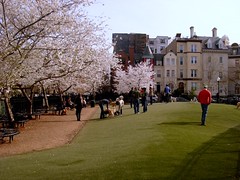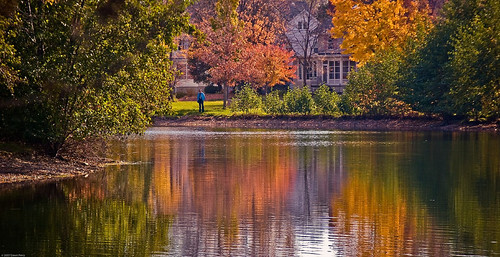The good news: we're getting more city parks. The bad news: we have less money to take care of them.

Posted December 13, 2011 at 1:40PM
The Trust for Public Land’s Center for City Park Excellence has released its most recent data on public park systems from the country’s 100 largest cities, which collectively added more than 120 parks in the past year. Unfortunately, despite the increase in parks, operational spending shrank slightly overall, with close to half of the cities in the study experiencing cuts. Full-time employee counts fell by 3.9 percent, a loss of 935 jobs nationwide. Peter Harnik, the Center’s director, says that cities have had to postpone some $5.8 billion in scheduled repairs and improvements.
The good news is that capital spending for parks – as opposed to operating and maintenance – grew 4.6 percent overall from 2009 to 2010, partly as a result of federal stimulus funding. TPL reports in a press release accompanying the publication of the new data that here in Washington, for example, stimulus support helped push National Park Service capital spending in the city from $4 million in FY 2008 to $56.3 million in FY 2009.
The popularity of city parks remains robust. Nearly half the primary park and recreation agencies reported more than a million visits during the most recent data year, and 14 boasted more than 10 million annual visits. Topping the list were New York (123 million visits), San Diego (72.3 million), and Chicago (50 million).
 The report includes information on urban park acreage, spending, staffing, and facilities. In its annual survey, the Center counts every kind of public park within the city boundary, including national, state, county, regional, and municipal parks. These include playgrounds and remote natural areas, flower gardens and paved plazas, and sports fields and bike trails.
The report includes information on urban park acreage, spending, staffing, and facilities. In its annual survey, the Center counts every kind of public park within the city boundary, including national, state, county, regional, and municipal parks. These include playgrounds and remote natural areas, flower gardens and paved plazas, and sports fields and bike trails.
If you’re like me, chances are you didn’t know that Norfolk and Las Vegas have twice as many dog parks per resident as do Tampa and Albuquerque, or that Seattle spends over four times as much per resident on taking care of its city parks as does Dallas. You might expect that big northeastern cities, along with Chicago and LA, and maybe cities in basketball-crazy Indiana, Kentucky, and North Carolina have the most basketball hoops per person. But you would be wrong: Madison and Norfolk are the winners in that category.
Madison not only has the most basketball hoops but also the most parks per capita, with 12.7 per 10,000 residents, followed by Cincinnati, St. Petersburg, Anchorage, and Buffalo. Madison also has more playgrounds per capita than any other city, with seven for every 10,000 residents. The next five are Virginia Beach, Corpus Christi, Cincinnati, and Norfolk.
According to the report, there are almost 20,000 community garden plots in the parks of the 100 largest cities. Despite being two of the coldest cities, St. Paul, Minnesota and Madison, Wisconsin were tops in the number of garden sites per 10,000 residents, with 35.6 and 32.9, respectively.
 Spread-out cities such as Anchorage and Albuquerque usually offer the most acreage per resident. (Anchorage is a special case, with the massive – 490,000 acres, or 765 square miles – Chugach State Park counted as part of its total.) Older, denser cities that still manage to offer residents large swaths of open space include Minneapolis (13.3 acres per 1,000 residents), Oakland, Washington, D.C., and Seattle. But operating quality parkland in dense cities does not come cheap – Minneapolis, Washington, D.C., and Seattle each spent $200 or more per resident, compared to a median of $84. The report helpfully allows comparisons of cities to others of similar density.
Spread-out cities such as Anchorage and Albuquerque usually offer the most acreage per resident. (Anchorage is a special case, with the massive – 490,000 acres, or 765 square miles – Chugach State Park counted as part of its total.) Older, denser cities that still manage to offer residents large swaths of open space include Minneapolis (13.3 acres per 1,000 residents), Oakland, Washington, D.C., and Seattle. But operating quality parkland in dense cities does not come cheap – Minneapolis, Washington, D.C., and Seattle each spent $200 or more per resident, compared to a median of $84. The report helpfully allows comparisons of cities to others of similar density.
Extremely difficult to measure on a national scale is a data point that I would find particularly telling: what percentage of a community’s residents live within walking distance of a public park? I believe that, while large parks definitely have their benefits, appropriately dispersed neighborhood-scaled parks are particularly valuable to the creation of livable cities. This measure is beyond the scope of the Center’s report, but I can’t help but think we are getting closer to being able to make useful conclusions and comparisons given the kinds of advances we are seeing in GIS-based systems such as Walk Score.
The Trust for Public Land’s Center for City Park Excellence began reporting data on city park systems a decade ago. This year’s data cover 22,493 city parks serving 62 million city residents.
Move your cursor over the images for credit information.
